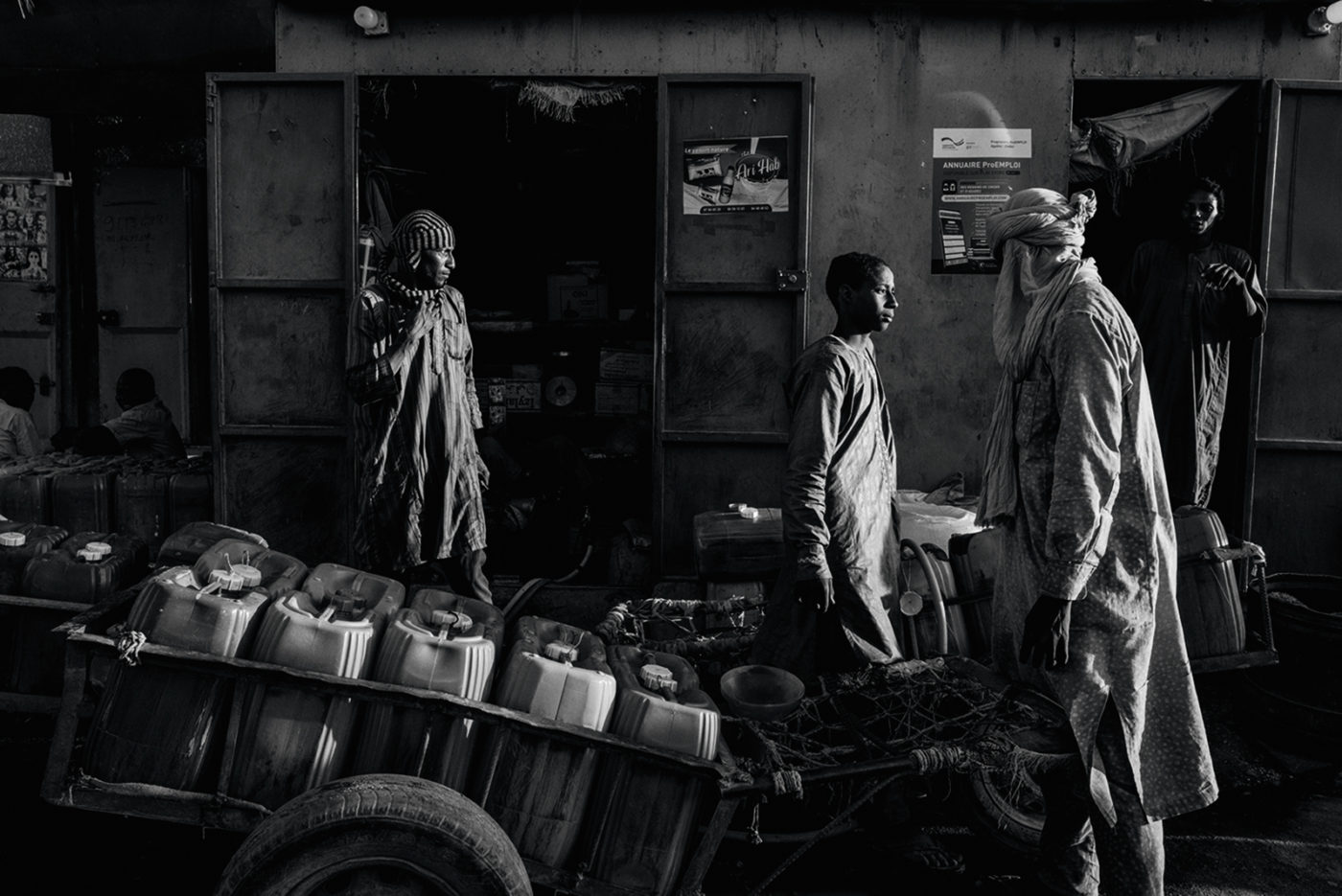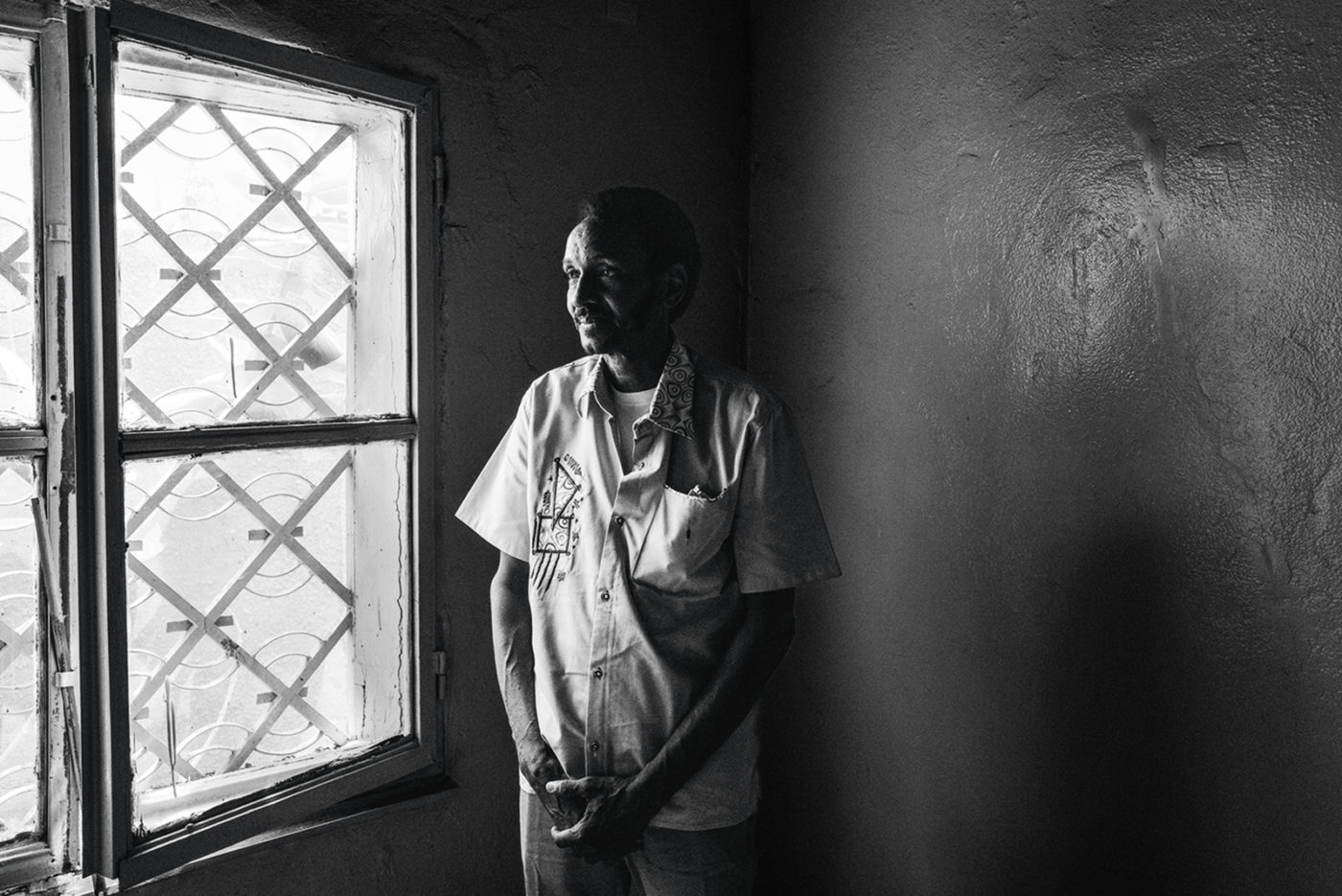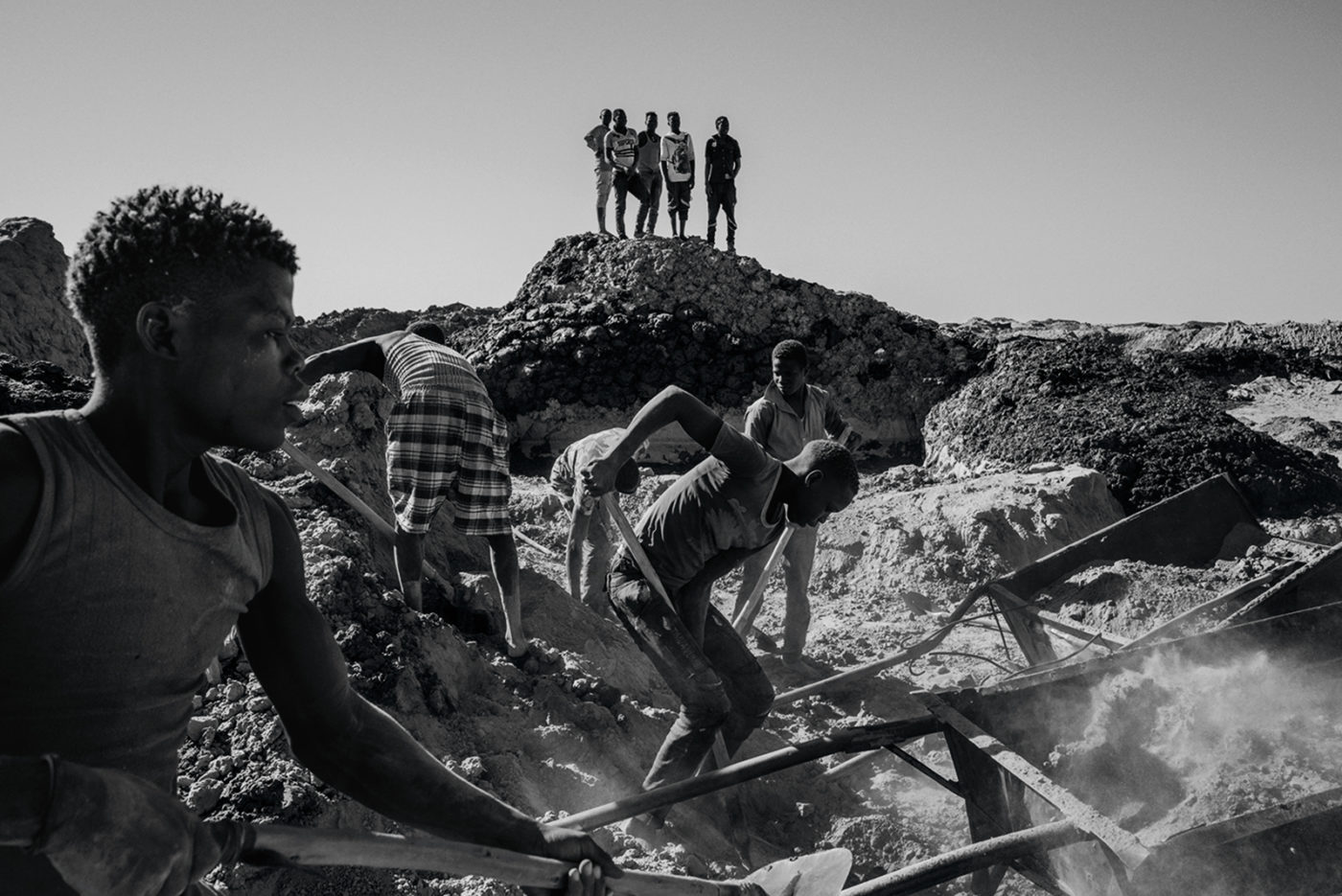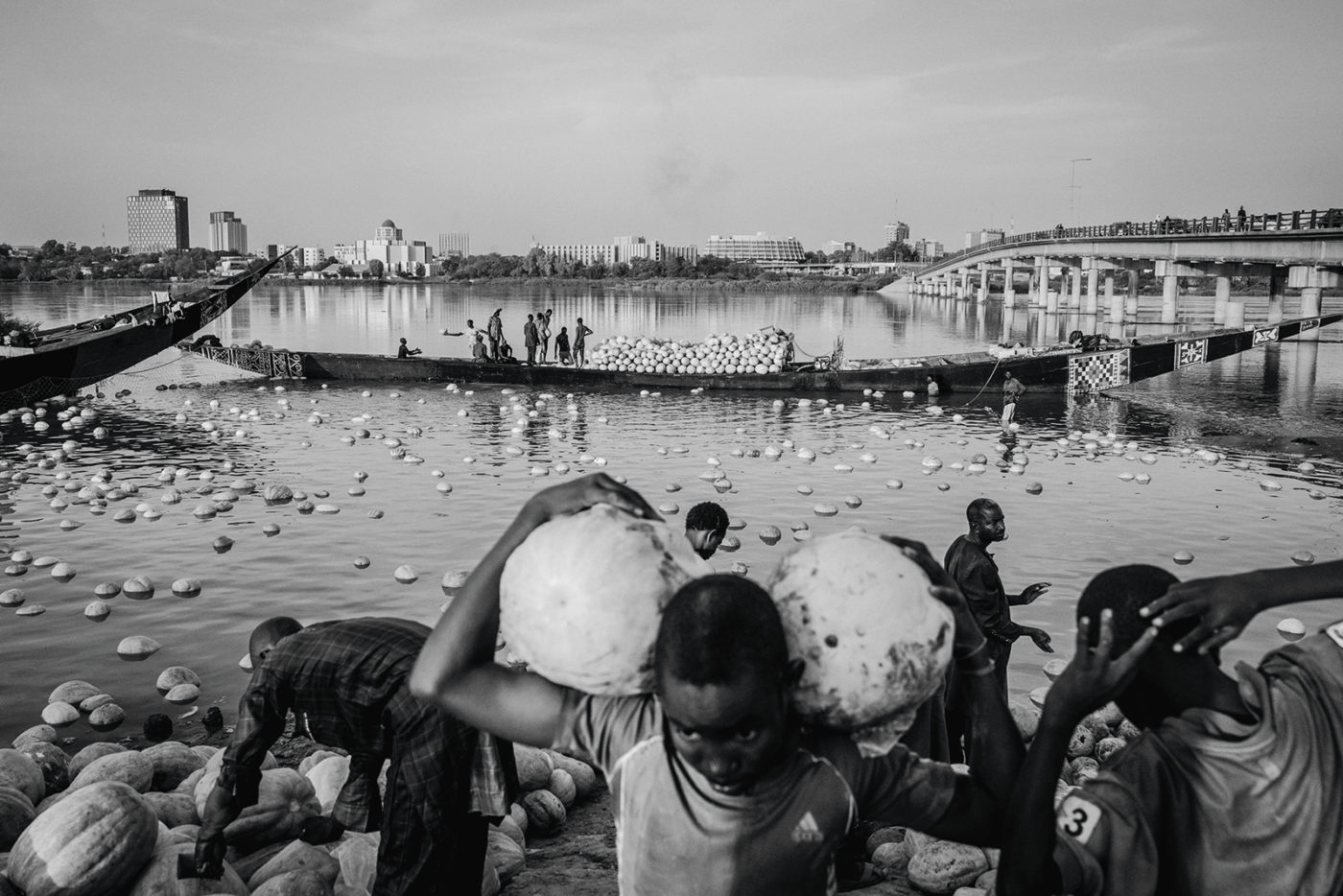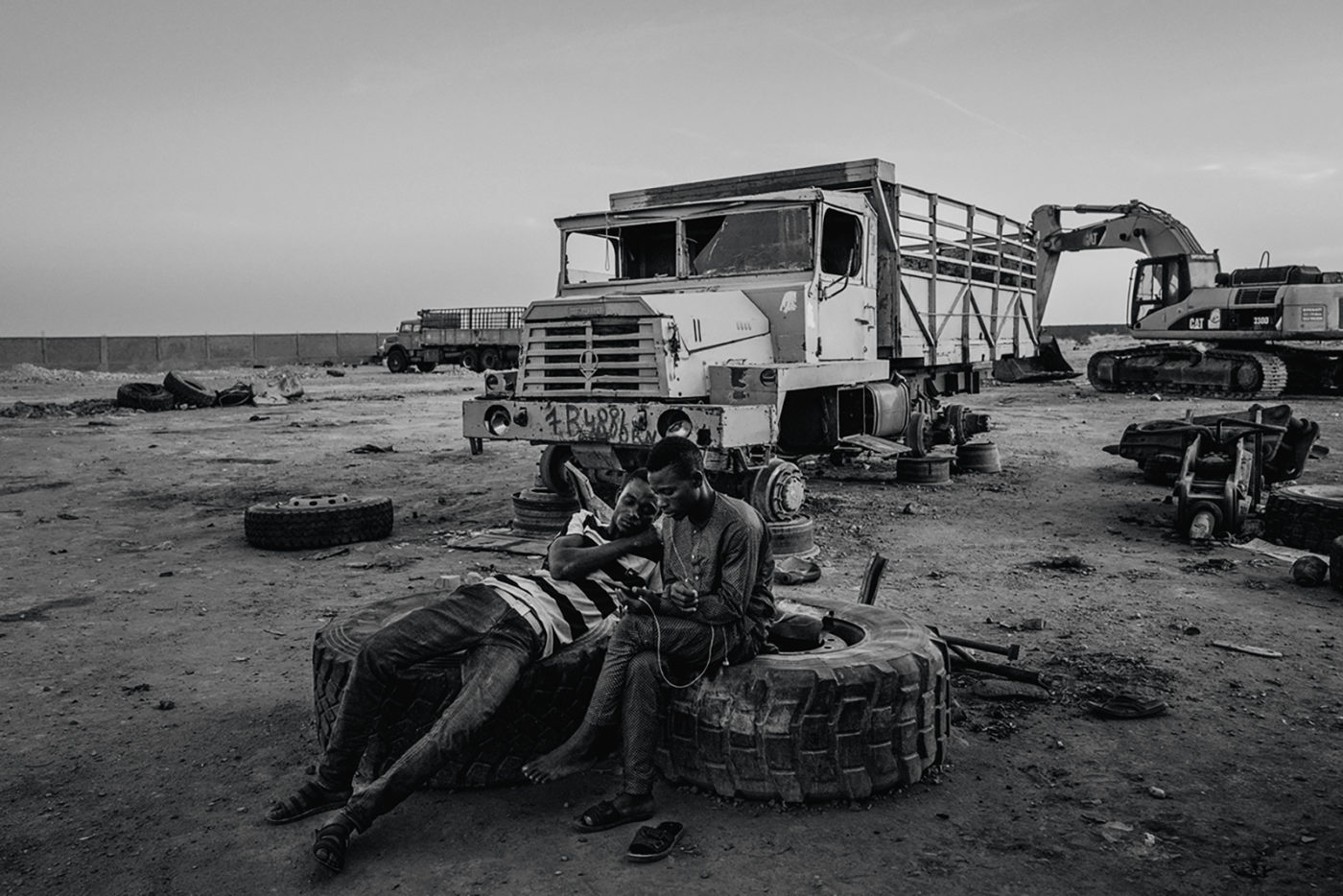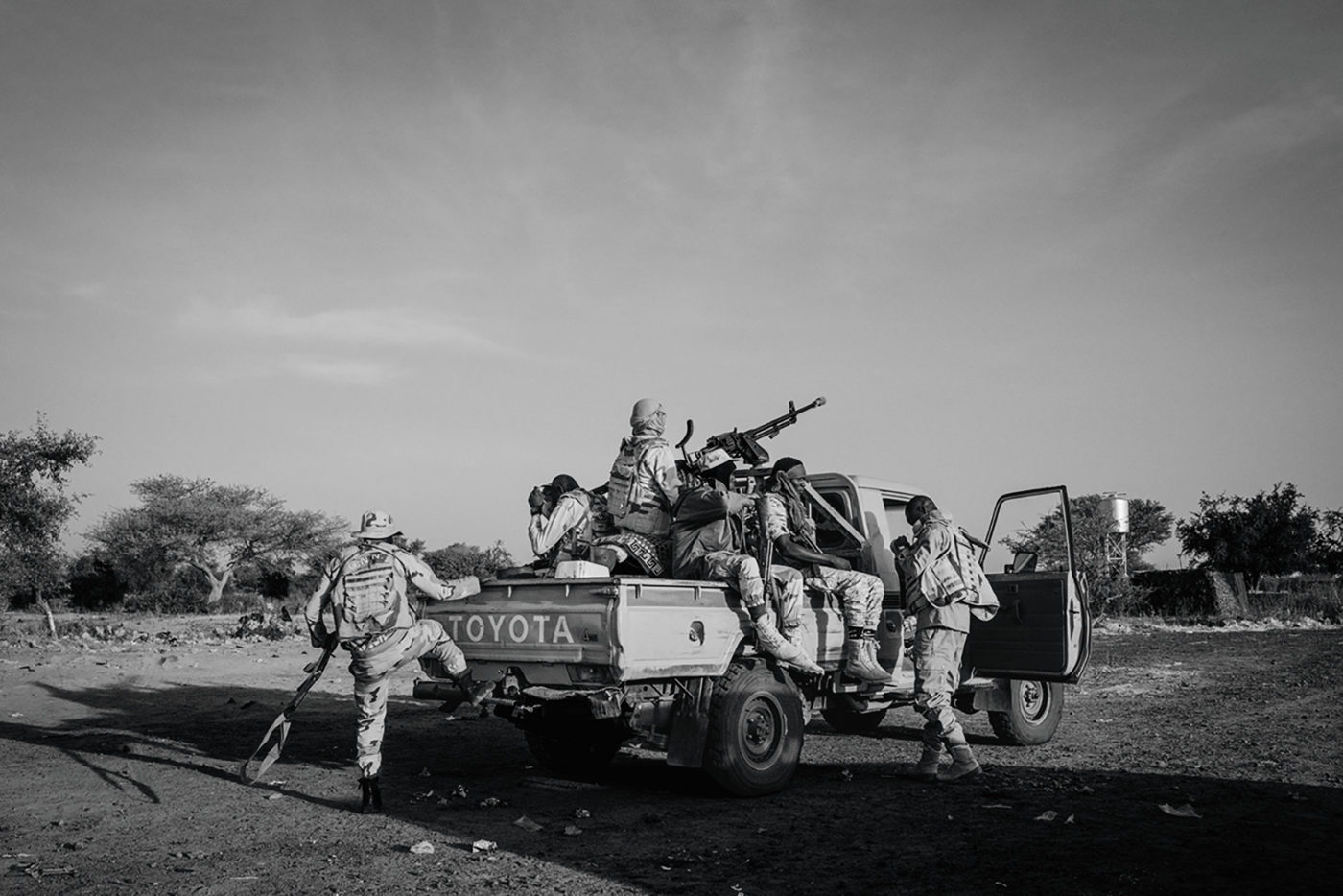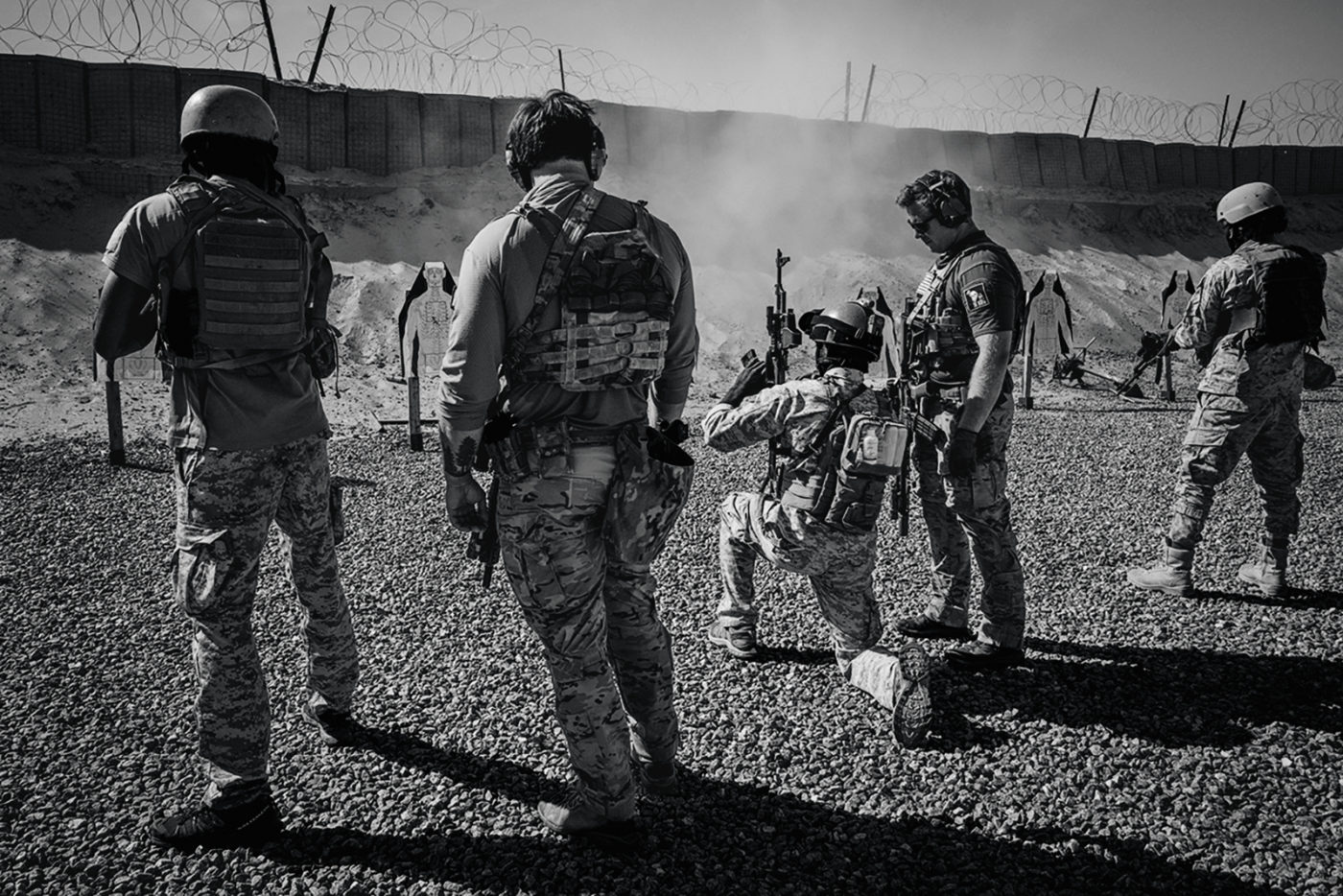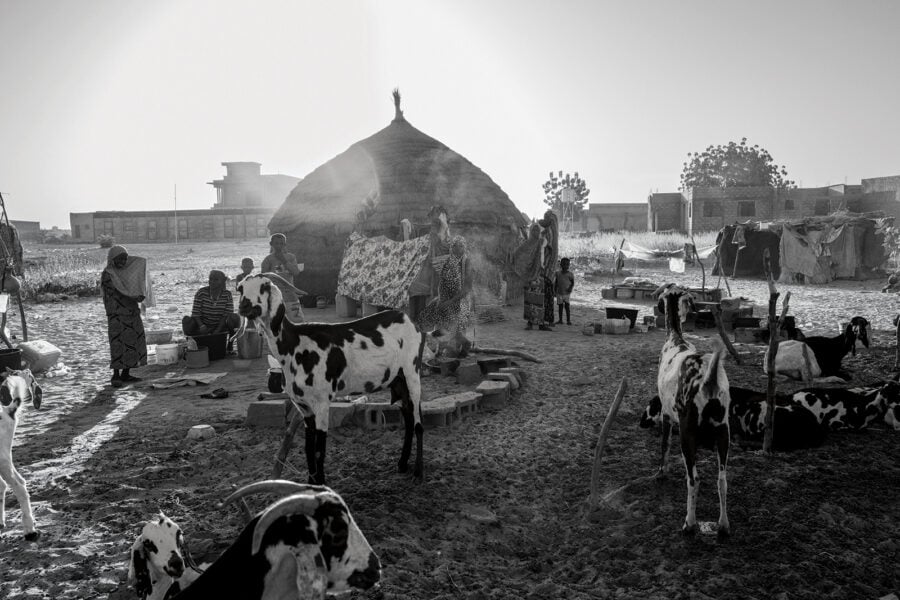
Peul herders at an encampment in Niamey. All photographs from Niger by Nicole Tung, November 2021, for Harper’s Magazine © The artist
“I like keeping things alive,” Boubacar Diallo told me. He had raised animals his whole life, a hobby he inherited from his father, a soldier in the Nigerien Army. “Anyone will tell you the address to my house is the place where the cattle are outside.” Diallo climbed a ladder to reach some hay bales on the roof of a ramshackle lean-to under which three goats, their fleeces the color of old snow, were huddled next to a flock of pigeons. He hopped down and tossed the bales into the pen. A few birds followed him.
It was early November 2021, and I was visiting Diallo at his home in Niamey, the capital of Niger. I was accompanied by a journalist named Omar Hama, and the three of us sat outside on a covered patio, beside a skinny tree stretching upward through a hole in the tin roof. The rainy season had ended a month earlier, and the banks of the nearby Niger River were lined with green. But the rain had fallen unevenly: across the country there were reports of flash floods, scrawny vegetables, and camels with strange diseases.
An unassuming man with scraggly sideburns and wrinkled clothes, Diallo works as a conflict mediator in Tillabéri, a region that surrounds Niamey, extending north to Mali and southwest to Burkina Faso. Tillabéri is home to several ethnic groups, including the Peul, or Fulani, who typically are nomadic herders; the Tuareg, who are also itinerant; and the Djerma, who are often farmers. Over the past decade, as agricultural plots have encroached on herder territory and climate change has made water and arable land increasingly scarce, the borderlands have seen sporadic violence. Tuareg bandits have stolen animals from Peul herders, and deadly feuds have broken out between Peul, Djerma, and Tuareg families.
Through painstaking negotiations, Diallo brokers truces and convinces warring groups to relinquish their weapons. But at the time of my visit, his work had been complicated by the growing presence of the Islamic State in the Greater Sahara (ISGS), an armed group that originated in Mali and capitalizes on conflicts in Tillabéri to recruit members and informants. Evading Nigerien Army patrols and French and American reconnaissance drones, their fighters had been raiding towns, executing local chiefs, and demanding that residents pay a tax or face retaliation. “The authorities refused to resolve the problems in the border zone, and the jihadis took advantage,” Diallo said. Hama nodded in agreement. Villages across Tillabéri were now emptying, their inhabitants fleeing to Niamey or to camps cropping up throughout the region.
The Nigerien government once encouraged Diallo’s peacemaking attempts in Tillabéri, even employing him for a time as a high-level adviser. But after several Peuls joined ISGS, Diallo, himself a Peul, was detained for ten days. “They consider me a militant,” Diallo told me, smiling. His wife, Fati, was fired from the school where she taught. Despite this persecution, the couple opened their home to strangers, who came to Niamey searching for loved ones detained or disappeared by the Nigerien Army. There were often people sleeping in their concrete courtyard, but on this particular night it was empty. After evening prayers, Diallo planned to go to bed early.
Shortly after sunset, Diallo’s and Hama’s phones vibrated.
“Oh my God,” Hama said quietly, rubbing his chin. “People are saying that the mayor of Banibangou has been killed in an ambush.” Banibangou is a municipality in northern Tillabéri, near the Mali border. A local self-defense militia led by the mayor had set out on patrol the previous morning; initial reports suggested that only a few members had returned. Both men had met the mayor before—Hama while on assignment, and Diallo while investigating a case of murdered herders.
Diallo scrolled through his phone and shook his head. It takes hours for accurate information to filter out of Tillabéri, a territory comprising some thirty-nine thousand square miles where cell phone reception is often non-existent. No one yet knew how many men had been killed. The closest Nigerien Army base to Banibangou—which also housed U.S. Special Forces—was eighty-eight miles away, in the town of Ouallam. By the time news of the attack reached the base, it was too late. This had been the case in hundreds of other raids, kidnappings, and lootings that occurred in Tillabéri over the previous two years. Neither the Nigerien military nor the foreign troops stationed in the country seemed capable of quelling the violence.
“Excuse me,” Diallo said, rising from his chair, his face illuminated by his smartphone. “I have to make some calls.”
When the United States pulled its troops out of Afghanistan in August 2021, President Joe Biden promised that the fight against terrorism would continue, albeit in a different form. “We have what’s called over-the-horizon capabilities,” he said, “which means we can strike terrorists and targets without American boots on the ground—or very few, if needed.” The model he proposed—continual aerial surveillance, drone strike capacity, and limited troops—is the same strategy the United States had already embraced in Niger to combat the incursion of militants from Mali, which, in addition to ISGS, includes one of its chief adversaries, Jama’at Nusrat al-Islam wal-Muslimin (JNIM).
The American military presence in the region dates to the early Nineties, when U.S. European Command (EUCOM), its activities diminished following the collapse of the Soviet Union, began looking to the Sahel as a new theater in which to operate. U.S. intelligence started monitoring the armed groups emerging out of the civil war in Algeria, but major resources were not allocated to the Sahel until the years following 9/11. The vast Sahara Desert, argued EUCOM, was an ideal breeding ground for extremism.
In November 2002, the State Department, in partnership with EUCOM, embarked on a terrorism prevention campaign in the Sahel that focused on Mali, Chad, Mauritania, and Niger, although no serious international terrorist threat existed. U.S. Marines and Special Forces began training national armies and monitoring militant groups. There was little oversight. William Jordan, a former State Department intelligence official, described a chaotic atmosphere in which local rebel groups were conflated with terrorist organizations. He recalled an incident in 2003 when U.S. forces narrowly avoided bombing an encampment of Malian civilians that EUCOM had wrongly insisted was linked to a terrorist group. In 2005, Congress authorized the Trans-Sahara Counterterrorism Partnership, a five-year, $500 million initiative that expanded train-and-equip programs to five additional countries. Two years later, the American military created a separate Africa Command (AFRICOM) to centralize operations on the continent, and doubled down on a strategy in the Sahel that seemingly ignored the growing hostility between state officials and rural citizens, many of whom felt neglected by autocratic governments that struggled to deliver services in remote areas.
The NATO-backed killing of the Libyan dictator Muammar Qaddafi in 2011 only exacerbated these tensions. Small arms and weapons flowed to neighboring countries, and fighters from the Sahel who had been working for Qaddafi returned home. In Mali, they helped launch a rebellion among the Tuaregs in the north that quickly disintegrated into a fight for power among numerous factions, including Islamist militant groups intent on imposing sharia law. At the urging of the Malian government, France, which has long-standing economic interests in Sahelian uranium, declared war in January 2013, eventually sending in several thousand troops.
The Americans, meanwhile, found that the neighboring Nigeriens were eager to prevent the conflict from spilling over the border. In February 2013, Obama notified Congress that he was deploying around a hundred military personnel to Niger. Since then, the country has received more than $500 million for defense spending from the U.S. government. From its hub in Niamey, which includes an armed-drone base, the American military has transported French troops, shared intelligence with French ground forces, and assisted with drone strikes in Mali, while also conducting its own counterterrorism operations. As of December 2021, 831 U.S. military personnel were stationed across Niger. In addition to the drone base in Niamey, there are two others: one in the desert city of Agadez, and another, operated by the CIA, in the remote outpost of Dirkou. The Agadez base is one of the most expensive installations ever built by the U.S. Air Force.
Despite these interventions, violence in the region is intensifying. According to the Armed Conflict Location and Event Data Project, a record 1,460 Nigeriens died in conflict last year, 727 of them civilians. Military coups have destabilized Burkina Faso and Mali, from which French troops withdrew in August. (Their operations were relocated to Niger.) Over five million people are displaced across the Sahel, and a food crisis sparked by drought and exacerbated by Russia’s invasion of Ukraine is widespread. Almost half the children in Niger do not have enough to eat.
AFRICOM, meanwhile, continues to defend its approach as a “light footprint,” and argues that its investment in the Sahel is necessary to protect American economic interests and combat the growing influence of China and Russia. Yet few details have been released about its operations, which show no sign of ending. As I read reports about the construction of armed-drone bases and listened to press briefings at the AFRICOM headquarters in Stuttgart, Germany, my questions about the reality of the military’s “over-the-horizon” capabilities grew. On a chilly October morning, I flew from Berlin to Istanbul, then boarded a flight to Niamey behind a group of weathered American men in cargo pants and boots, who I assumed were military contractors. We landed near midnight in an air-conditioned airport, empty except for security officials and soldiers. I stepped outside, suddenly enveloped by the heat, and found Hama waiting there, waving his red baseball cap in the deserted parking lot.
The day after the attack on the Banibangou convoy, details began to emerge: the organized civilian militia, consisting of some eighty-four Djerma men on motorcycles and headed by the mayor of Banibangou, had gone out in the morning on patrol, reportedly intending to detain Peul herders. Around 9:30 am, near the small village of Adab-Dab, the group was intercepted and overwhelmed by ISGS fighters. Sixty-nine men from Banibangou were killed.
The U.S. Embassy in Niamey released a statement condemning the attack: “We maintain our commitment and partnership to the Nigerien people and the Nigerien armed forces as we seek to eliminate violent extremists and their godless ideology from the region.” The Nigerien president Mohamed Bazoum declared two days of national mourning, and took a helicopter to Banibangou, where he addressed the villagers. “If you think that you can provide your own defense, that’s legitimate,” he said. “But the one who must ensure your defense and on whom you must rely is the state.”
It was difficult to take the president seriously. Between 2011 and 2019, Niger spent $875 million on defense, but an audit found that $320 million in contracts had been inflated or awarded through rigged bidding processes. Beyond the corruption, Nigerien soldiers have conducted mass arrests, and in some cases extrajudicial executions, of Peul herders during counterterrorism sweeps. The National Human Rights Commission, which relies heavily on information from Diallo’s organization, the Council of North Tillabéri Herders, found that Nigerien soldiers had disappeared or killed 136 civilians in Tillabéri in 2020. Seventy-two bodies were later found in hastily dug mass graves; many were handcuffed and blindfolded. To date, no soldiers have been prosecuted.
In Niamey, the conflict in the borderlands seems to drive much of the local economy. According to the Observatory of Economic Complexity, the top import to Niger is rice, followed by “explosive ammunition,” a category that includes “bombs, grenades, torpedoes, mines, missiles.” In addition to the Americans, Niamey hosts some one thousand French soldiers, as well as detachments from Algeria, Belgium, Canada, the Netherlands, Italy, and Spain; a UN peacekeeping force for Mali; the European Union’s security attachés; and soldiers from the G5 Sahel, a joint initiative among Burkina Faso, Mali, Chad, Mauritania, and Niger. (Mali withdrew this summer.) Many of these foreign troops, focused on a nebulous mix of counter-insurgency and border-control efforts, slip in and out of the city in armored vehicles. Often, they stay in new, gated hotels near the Kennedy Roundabout. At the Radisson Blu hotel’s New York Restaurant, military contractors and diplomats gather around the pool to sip fluorescent cocktails. One night, I caught a glimpse of Linda Thomas-Greenfield, the U.S. ambassador to the UN, as a convoy whisked her away from the plush hotel to a UN Security Council event. The then commander of AFRICOM, General Stephen Townsend, was also in town, meeting with the French. In the garden of an Italian bistro designed to resemble a desert dwelling, I overheard a man tell his companion, who worked for the UN, that he was with the German special forces, who were here doing “intelligence gathering” and “some advising.”
Three days after the attack, I stopped by the office of General Mahamadou Abou Tarka, who oversees Niger’s High Authority for the Consolidation of Peace. I wanted to ask him how all the foreign militaries buzzing around Niamey had affected the conflicts near the border. Tarka, wearing a taupe uniform with a green beret, was dismissive. “We have, what, twenty of the Italian military training our people, or we have thirty-five Spaniards training the gendarmerie?” To Tarka, the number of foreign troops was negligible. Far more pressing, he said, was the need to build up their own forces. The government had roughly thirty-five thousand troops to control an expanse of territory that Tarka estimated would require closer to one hundred and fifty thousand.
“You know, here is not Afghanistan,” he said over the hum of a fan. “We are a functioning state, we have national armed forces, and we were not created by the Americans. Our government is a legitimate one. That’s why we are asking for help with helicopters and logistics. We want military fortresses on the borders—France is helping us do that. America, not yet.” Yet toward the end of our interview, Tarka seemed skeptical that any amount of resources would be enough to stabilize the country. He even suggested that some Nigeriens should learn to live under terrorist groups. “It’s better to pay a zakat and live in dignity than to live in a refugee camp and become a beggar,” he said. “Of course, it’s better if we can offer security. But the military of Niger can never secure this big country.”
The United States maintains that its mission in the Sahel is to promote development and diplomacy, but as I spoke to more people in Niamey, it was difficult to discern a coherent strategy. Diplomacy seemed subsumed by security. Years ago, Diallo had received conflict-mediation training from the State Department. But recently, the department’s focus shifted to local police forces. USAID funds humanitarian programs across the country, responding to acute crises, but there is little emphasis on addressing governance and human rights abuses, and several aid agencies told me their access to the borderlands was limited by the government. When AFRICOM offered me the opportunity to speak with the commander of the U.S. Special Operations Task Force for North and West Africa, who was visiting from Chad, I hoped that he could offer some insight into the military’s long-term objectives.
Four nights after the attack, I headed to Air Base 101 with the photographer Nicole Tung. The reporting parameters were strict: the commander could only be identified by rank, no photos were allowed, and we were denied a general tour. The base, the first stop for most Special Forces troops stationed in the region, is located next to Niamey’s small international airport, near a neighborhood whose houses are jammed so tightly together it’s known as the Netherlands. Street vendors hawked plump watermelons and fiery peppers. Young Nigerien soldiers manned the complex’s gated entrance, where a Special Forces liaison picked us up in a black SUV, then guided us through a maze of barricades. We passed a contingent of the Italian Army, who we were told were renting land from the United States. During their downtime, the driver said, they cook homemade pasta.
We arrived at the Special Forces unit of the base, which consisted of a series of non-descript containers next to an empty, open-air bar with a colorful sign that read, welcome to niami! We surrendered our phones and entered an immaculate, windowless beige chamber. There we met the task force commander, a reticent and trim, middle-aged man in uniform, and the Advanced Operating Base commander for Niger, who wore a camo baseball cap and looked a bit younger and more relaxed.
I asked them why, despite its sophisticated aerial surveillance, the United States was seemingly incapable of predicting attacks like the one in Banibangou. “We just can’t look everywhere all at the same time,” said the task force commander. “That is, unfortunately, not a realistic expectation.” His counterpart jumped up and fetched a map of Tillabéri, which he spread out on the table to illustrate the distances between villages.
The task force commander emphasized that U.S. Special Forces are not allowed “anywhere close” to the front lines. “We train [Nigerien troops] at the tactical level, and then enhance their capabilities once they go out and execute operations, based off intel collected both on the U.S. and the Nigerien side,” the AOB commander said.
I pressed them on what such remote supervision looked like in practice, but the task force commander refused to go into more detail. Later, the AOB commander told me that the U.S. military had seeded the idea for a large-scale operation conducted by Niger and Burkina Faso that took months of planning and high-level coordination. He did not name it, but I surmised that this was an operation called Taanli 1, which, according to an enthusiastic press release from the Burkina Faso government, “neutralized 100 terrorists” affiliated with JNIM. There was no press release from AFRICOM.
In the conference room, I asked question after question about AFRICOM’s strategy in Niger, but gleaned very little. As for the allegations of extrajudicial killings of Peuls and other abuses by Nigerien soldiers, the task force commander agreed they were a concern, but assured me that “Niger actually does a good job of investigating.” When I asked if military responses to violent extremism could ever end the attacks in Tillabéri, the commander paused. The men looked at each other and laughed awkwardly. “That’s a good question,” the AOB commander said. “The security efforts help buy space and time to try to have other development efforts, or new governance efforts,” explained the other. It was unclear what reforms the United States was actually willing to support.
I had also requested to visit Air Base 201, the drone site in Agadez, but the Air Force did not like the idea. So one evening, I headed downtown to the distressed Grand Hotel, where I met an investigative journalist from Agadez named Ibrahim Diallo (no relation to Boubacar). His news organization, Aïr Info, documented the crash of three armed drones in the northern desert, near the Libyan border. At night, said Diallo, the base pollutes the sky with light and the sound of buzzing aircraft.
When 201 opened, he went on a site visit, but the Air Force refused to answer most of his questions. The Americans are seen in town only on occasion, but rumors of their presence abound: how they dig tunnels under cover of night, and use their planes to smuggle gold out of the country. The speculation, Diallo said quietly, pointed to a growing distrust of the U.S. military presence. “The Americans don’t have friends. Just like any other army, they only have interests.”
Diallo worried that the increasing number of foreign soldiers in Niger was steering the country toward ethnic conflict. “All the traditional mechanisms to resolve conflicts—they are putting them aside. War becomes the only solution,” he said. Soon, he worried, “Peuls will be persecuted everywhere. They’ll be killed. It’s started already, but I hope that I’m wrong.” (A few months later, Diallo’s fears were confirmed when mercenaries from Russia’s Wagner Group began fighting in Mali alongside the army; on one “counter-terrorism operation” in the town of Moura, they are believed to have massacred some three hundred people, predominantly Peuls.)
The Nigerien government has taken tentative steps toward negotiating with the insurgent groups, including ISGS, and many other African countries and regional institutions see mediation as essential to ending the spiraling conflict. But the French and Americans remain firmly opposed to dialogue. “I heard the Americans won’t support negotiations, but why not?” asked Boubacar Diallo. “They did in Afghanistan.”
I understood Diallo’s point, but the two conflicts do not strike me as neatly analogous. More than two thousand American service members died in Afghanistan. Public opinion had soured on the occupation, and though many in the military wanted to stay, politicians were adamant that it was time to leave. In Niger, there is no such pressure. The over-the-horizon approach means that there have been few American deaths, and little media attention. Far from scrutiny, the war on terror marches mindlessly on.
An hour-and-a-half drive from Niamey is the town of Ouallam. On its outskirts sits a large Nigerien military base shared with a U.S. Special Forces team. Because of the base, Nigeriens consider Ouallam to be a safe haven, and it hosts a growing camp for Nigeriens forced from their homes, as well as one for refugees from Mali. I wanted to get a good look at the Special Forces’ day-to-day operations and hear directly from some of the estimated hundred thousand displaced people within Tillabéri.
The Nigerien government prohibits foreigners from leaving the capital without an armed escort, claiming that the security risk is too high. Conveniently, the Nigerien national guard was available for hire, at five hundred dollars a day. Hama, Tung, and I, along with a translator I’ll call Mounkaila, left Niamey early in the morning and drove to an exit checkpoint, where two Land Cruisers were waiting for us, each filled with seven men carrying AK-47s. A Nigerien official who worked at the camp insisted on joining us in his own car.
We sped through the countryside, glimpsing the occasional gas station or school. The land was pocked with short, leafy garbeye trees, the sky smoke-blue and cloudless. Mounkaila, who is Djerma, pointed out clusters of thatch Peul huts that serve as temporary settlements; several times a year, the Peuls pack them up and move. As the convoy passed, several people walking or working on the side of the road instinctively held up their hands in surrender or dropped to the ground.
The signs of development organizations heralded our arrival in Ouallam: UNHCR, UNICEF, GIZ, IOM. We stopped in for a customary visit at the mayor’s office, then abandoned our armed escort and proceeded in a beat-up red Corolla to meet the Special Forces. The American portion of the base was fairly simple, with a few small buildings separated from the road by a swath of gravel and a low barbed-wire fence. In an empty field sat two helicopters that the U.S. Army uses to evacuate wounded Nigerien soldiers to 101. At the gate, we were met by the attachment commander, a clean-cut thirty-one-year-old with cropped brown hair, who ushered us through. It was around 9 am, and some Green Berets had just begun a session training members of the elite 1st Expeditionary Force of Niger in counterinsurgency tactics.
In an open-air classroom with a blackboard, a few dozen Nigerien soldiers were being instructed in how to locate and dismantle IEDs. Next door was a firing range, where exercises were under way. A Nigerien translator delivered the instructions of an American weapons specialist in French. “You get a good site picture, get a shot. At your own pace, take your time.” Eight Nigerien soldiers formed a line, raised their rifles, and focused on some distant cardboard figures. Pop, pop, pop. Sand shot up from the ground. The air smelled vaguely of bleach.
As the men paused to take aim again, I asked the commander and two other soldiers whether the United States was succeeding in preparing the Nigerien Army to better anticipate attacks by insurgents. “It’s hard to know where they are at all times,” the commander explained, offering us earplugs. “Four motorcycles will show up with eight dudes and start shooting; that’s hard to anticipate.” During the rainy season, he said, the land becomes a swamp. In a truck, it can take three days to move twelve miles. The Americans could train the Nigeriens in combat techniques, but they lacked the ability to move as quickly as their adversaries.
Target practice concluded around 10 am, and we strolled around the outpost, which consisted of sleeping quarters, a small canteen (lunch special: pulled pork), an outdoor gym and training facilities, and a headquarters. Parked at the entrance to the office were five armored troop vehicles for the Americans and a few Nigerien pickup trucks with machine guns clipped to their roofs. A sign by the door listed the names of the four American soldiers who had been killed in the 2017 Tongo Tongo ambush, in which ISGS militants attacked a convoy of American and Nigerien troops. “The threat was unknown at the time,” the commander said as we entered. “We’ve gained a lot more situational awareness of the area, we know the threat better.” On his shoulder was a pin with the American and Nigerien flags fused together.
The Americans told me that they liked Ouallam, that it had a “family atmosphere,” and that the work was rewarding. “I would come back here in a heartbeat,” said one soldier. In the back room, a small kitchen was crammed with Krispy Kreme coffee, lemon energy gels, and jars of Nutella. A game of Settlers of Catan was set up on the coffee table.
We climbed up to the roof and looked out at the base. Next to the American sector were tents for the French and the Canadian liaisons, and in the distance was a gleaming row of new barracks for the African soldiers participating in a State Department–funded training program for the UN stabilization mission in Mali. Better living quarters were supposedly arriving soon for the U.S. troops as well. “We recognize we’re not going to fix the Sahel in six months,” one soldier told me. “There’s the metaphor of pushing a boulder up a mountain.”
The soldiers in Ouallam seemed genuine in their desire to support the Nigerien Army, but it was clear that no one could see an end goal. The U.S. military leadership knows that building bigger and better armies will not end conflict in the Sahel. But in the absence of a directive to prioritize non-military solutions, the same failed strategy churns forward. The presence of so many international forces, all with their own objectives, compounds this quagmire, emboldening the Nigerien military instead of strengthening government accountability. Despite AFRICOM’s protestations to the contrary, there was nothing light about their footprint.
We left the base and decided to head to the nearby displaced-persons camp. As we started the car, the Nigerien aid official demanded a fee: twenty dollars for gas, and an additional thirty dollars for entry into the camp. A loud argument ensued. Eventually, Hama paid the fee. The official hopped in his car, waved, and sped back toward the capital.
The camp was a cluster of reed-and-plastic huts on the edge of town. As far as I could tell, there were no services being offered. Inside one of the huts, Mounkaila and I met Mari, a thirty-five-year-old Djerma woman, who was soaking rice while her children played. A few days ago, she said, she was returning to her house after collecting water when she heard the sound of bikes. She had long glimpsed groups of motorcycles on the horizon. Now she watched as armed insurgents descended on the village. They picked her husband out of the crowd and ordered him to lead the cows out of town. When her husband disappeared from sight, Mari assumed he was dead. As her neighbors prepared to flee, grabbing only what they could carry, Mari gathered her five children. “It was everybody for themselves,” she said, leaning forward, beaded bracelets jingling on her wrist. “Some people even left their children behind.” A few hours later, her husband returned. He did not know why, but the men had spared his life. It had taken the family a week to reach Ouallam. More were on the way.
Mari had received little to no aid from the Nigerien government, or from the many international humanitarian organizations I had seen on the road. “Some people” had come to collect their names, but she did not know who they were. Locals had provided rice and water, but it was not enough. At night, the hut grew freezing. “I’m hungry,” Mari told me as one of her children crawled across her lap. “My life depends on God.”
Next door we found Seyou, a fifty-five-year-old grandmother in a plaid abaya. I could make out the shape of someone wrapped in thick blankets on the floor. This was Seyou’s daughter-in-law, Mamou. She was sick. They had left Banibangou together, walking by night, and when they arrived in Ouallam, Mamou had come down with a fever. Despite the pulsing heat, she felt icy. Mamou’s son, a toddler, crawled over to her, pushing his feet up against her side. Seyou had spent her whole life in Banibangou, which, she told me, meant “water of peace” in Djerma. “We don’t know if we’re going back,” she said.
Something moved under the blanket, startling us. Seyou reached under the comforter and pulled out a baby by the foot. This was her grandson Shamsouna. He had been born just six days earlier. “They were shooting while she was trying to deliver the baby,” Seyou said matter-of-factly. “He was born the day of the attack.” Mounkaila halted mid-translation; struggling to maintain his composure, he stepped out of the tent. Seyou cradled Shamsouna as his eyes adjusted to the light, his face scrunched in repose or pain, I could not tell which.

